Related Research Articles

The bowline is an ancient and simple knot used to form a fixed loop at the end of a rope. It has the virtues of being both easy to tie and untie; most notably, it is easy to untie after being subjected to a load. The bowline is sometimes referred to as king of the knots because of its importance. Along with the sheet bend and the clove hitch, the bowline is often considered one of the most essential knots.
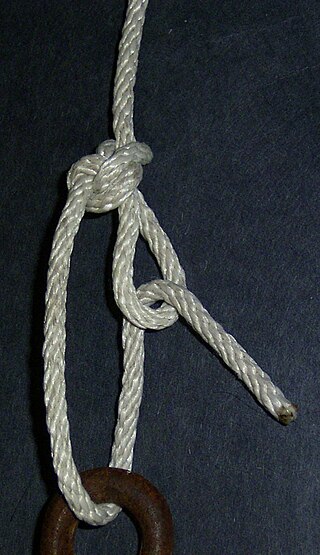
The trucker's hitch is a compound knot commonly used for securing loads on trucks or trailers. The general arrangement, using loops and turns in the rope itself to form a crude block and tackle, has long been used to tension lines and is known by multiple names. Knot author Geoffrey Budworth claims the knot can be traced back to the days when carters and hawkers used horse-drawn conveyances to move their wares from place to place.

Figure-eight loop is a type of knot created by a loop on the bight. It is used in climbing and caving.
The Flemish loop or figure-eight loop is perhaps stronger than the loop knot. Neither of these knots is used at sea, as they are hard to untie. In hooking a tackle to any of the loops, if the loop is long enough it is better to arrange the rope as a cat's paw.
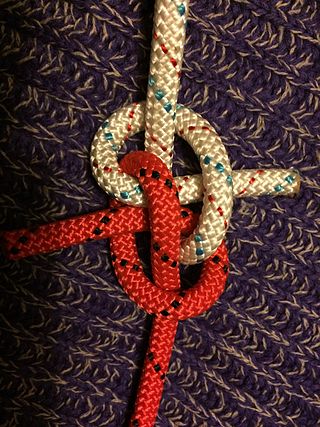
A zeppelin bend is an end-to-end joining knot formed by two symmetrically interlinked overhand knots. It is stable, secure, and highly resistant to jamming. It is also resistant to the effects of slack shaking and cyclic loading.

A blood knot is a bend knot most usefully employed for joining sections of monofilament nylon line while maintaining a high portion of the line's inherent strength. Other knots used for this purpose can cause a substantial loss of strength. In fly fishing, this serves to build a leader of gradually decreasing diameter with the castable fly line attached at the large diameter end and the fly or hook at the small diameter end. The principal drawback to the blood knot is the dexterity required to tie it. It is also likely to jam, which is not a concern in fishing line, which is no great loss to cut, but may be a concern in normal rope. "Blood knot" may refer to "a double overhand knot tied in a cat-o'-nine-tails."
The barrel knot, called blood knot by Keith Rollo, is the best bend there is for small, stiff or slippery line. The ends may be trimmed short and the knot offers the least resistance possible when drawn through water.
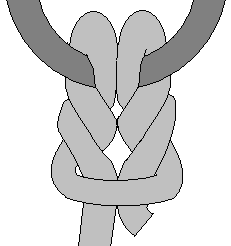
The Cat's paw is a knot used for connecting a rope to an object. It is very similar to the cow hitch except there is an additional twist on each side of the bight, making it less prone to slipping.
The cat's-paw is the common hook hitch for slings. It is the same basic form as the bale sling hitch but has additional twists. Brady says "two or three altogether," and Steel, who mentioned the name in 1794, says "three twists." It is the best of all sling hitches and is often recommended for a slippery rope. But no hitch can slip when tied in a slings since it has no ends. All that is needed is a hitch that cannot jam, and this requirement the cat's-paw fills admirably. The knot spills instantly when removed from the hook. It is the hitch always used for heavy lifts.
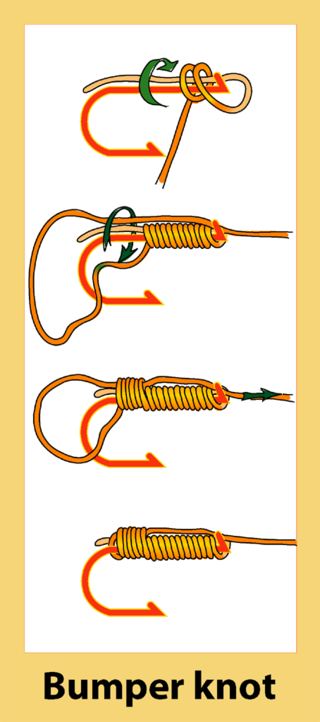
In fishing, a bumper knot can be used to secure soft or loose bait, including clusters of eggs, to a hook.

A fish hook or fishhook, formerly also called an angle, is a hook used to catch fish either by piercing and embedding onto the inside of the fish mouth (angling) or, more rarely, by impaling and snagging the external fish body. Fish hooks are normally attached to a line, which tethers the target fish to the angler for retrieval, and are typically dressed with some form of bait or lure that entices the fish to swallow the hook out of its own natural instinct to forage or hunt.

A becket hitch, including the double becket or figure-of-eight becket hitch, is any hitch that is made on an eye loop, i.e. on a becket. A becket hitch has the same structure as the sheet bend, which joins, or "bends", the ends of two ropes together. The becket hitch, in contrast, fixes a rope to a closed eye or hook. In this instance, a becket means the eye or hook of a pulley block, an eye in the end of a rope, or a rope handle on a sailor's sea chest.
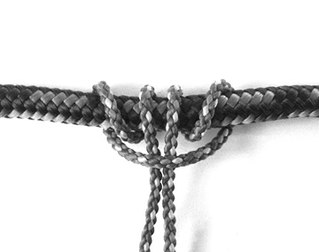
A Prusik is a friction hitch or knot used to attach a loop of cord around a rope, applied in climbing, canyoneering, mountaineering, caving, rope rescue, ziplining, and by arborists. The term Prusik is a name for both the loops of cord used to tie the hitch and the hitch itself, and the verb is "to prusik" or "prusiking". More casually, the term is used for any friction hitch or device that can grab a rope. Due to the pronunciation, the word is often misspelled Prussik, Prussick, or Prussic.

The eye splice is a method of creating a permanent loop in the end of a rope by means of rope splicing.

The nail knot, also known as the tube knot or gryp knot, is mostly used in carp and fly-fishing. The nail knot was named because a nail was inserted as a guide when threading the line. Today, it is easier to use a small straw. The nail knot is an important fishing knot used to join two lines of different diameters and allows for line diameters to diminish down to the fly. I.E., it is useful for attaching your backing to the fly line, and your fly line to the leader, or tippet. The knot can be tied in multiple ways and is uniform.

The double overhand knot or barrel knot is simply an extension of the regular overhand knot, made with one additional pass. The result is slightly larger and more difficult to untie. It forms the first part of the surgeon's knot and both sides of a double fisherman's knot. According to The Ashley Book of Knots, "A double overhand knot tied in a cat-o'-nine-tails is termed a blood knot."

The Palomar knot is a knot that is used for securing a fishing line to a fishing lure, snap or swivel.
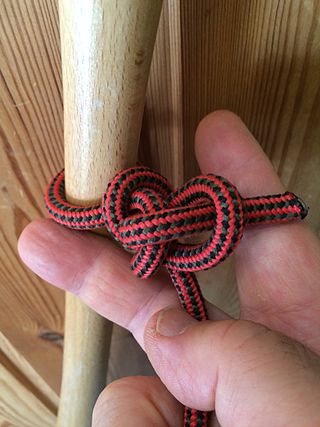
The falconer's knot is a knot used in falconry to tether a bird of prey to a perch. Some sources show this knot to be identical to the halter hitch, but with a specific method of single-handed tying needed when the other hand is occupied holding the bird.
Braided line was one of the earliest types of fishing line, and in its modern incarnations it is still very popular in some situations because of its high knot strength, lack of stretch, and great overall power in relation to its diameter.

The Trilene knot is a multi purpose fishing knot that can be used for attaching monofilament line to hooks, swivels and lures. It resists slippage and failures. The knot was apparently in use at least as early as 1975 when it was included in Tom McNally's Complete Book of Fishermen's Knots as the "double-looped clinch knot". However, professional anglers Jimmy Houston and Ricky Green would later claim that they invented the knot in the late 1970s while experimenting during promotional events for Trilene, a fishing line manufacturer. Both men favored the idea of naming the knot after themselves, though Trilene ultimately applied its own name instead. It's unclear whether Houston, Green or Trilene were aware of the knot's earlier invention or its prior inclusion in McNally's book.
The knotless knot is a hitch knot used to attach an eyed fishing hook to fishing line while leaving a length of line hanging below the hook. The extra length of line can then be used as the hair of a hair rig.
References
- ↑ John Neporadny, Jr. (2013). 101 Bass Fishing Tips: Twenty-First Century Bassing Tactics and Techniques from All the Top Pros. Skyhorse Publishing Inc. pp. 200–. ISBN 978-1-62087-792-0.
- ↑ Merwin, John (3 February 2009). "Fishing Knots: How to Tie The Four Strongest". Field & Stream. Archived from the original on 7 February 2013.
- 1 2 "Tying the San Diego Jam Knot". Salt Water Sportsman. 27 August 2019. Retrieved 17 November 2022.
- ↑ Etienne van Heerden (1 September 2013). Klimtol (in Afrikaans). Tafelberg. pp. 344–. ISBN 978-0-624-05726-0.
- 1 2 "San Diego Jam Knot". Animated Knots. Grog. Retrieved 17 November 2022.
- ↑ Sealock, Jason (1 December 2013). "How to Tie the San Diego Jam Knot". Wired2Fish.com. Retrieved 17 November 2022.
- ↑ Mansur, Robin (15 September 2008). "How to Tie a double San Diego jam knot for fishing". WonderHowTo. Retrieved 17 November 2022.
- ↑ Sealock, Jason (1 December 2013). "How to Tie the Doubled San Diego Jam Knot". Wired2Fish.com. Retrieved 17 November 2022.
- ↑ "San Diego Jam Knot – How to tie a San Diego Jam Knot". NetKnots.com. Retrieved 17 November 2022.